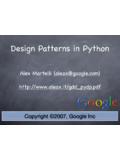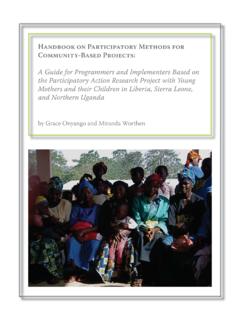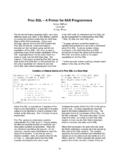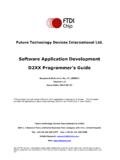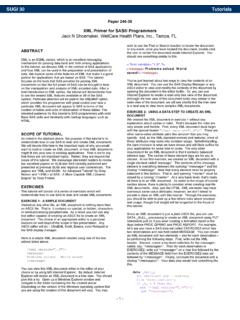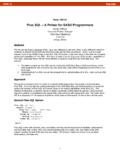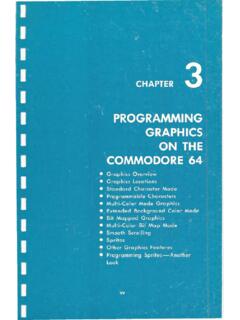Transcription of Python For Programmers - Alex Martelli
1 Python For Programmers 2007 Google -- This talk's audience mildly to very experienced Programmers in 1 (or, better, more) of Java, C++, C, Perl, .. no previous exposure to Python needed a little bit can't hurt but, if you already know Python well, you will probably end up rather bored!-). ready for some very fast & technical parts as well as some more relaxed ones:-). tolerant of short names and too-compact formatting (to squeeze in more code/slide!). 2. What's Python [1]? a "very high-level language", with: clean, spare syntax simple, regular, powerful semantics object-oriented, multi-paradigm focus on productivity via modularity, uniformity, simplicity, pragmatism a rich standard library of modules lots of 3rd-party tools/add-ons several good implementations CPython , pypy , IronPython [.]
2 NET], (Jython [JVM]). 3. What's Python [2]? a strong open-source community many users (both individuals and companies) in all fields the Python Software Foundation sub-communities for special interests many local interest groups sites, newsgroups, mailing lists, .. courses, workshops, tutorials, .. and an inexhaustible array of BOOKS! online-only, paper-only, or both 4. Lots & LOTS of good books 5. Similarities to Java typically compiled to bytecode but: compilation is implicit ("auto-make"). everything inherits from "object". but: also numbers, functions, classes, .. "everything is first-class". uniform object-reference semantics assignment, argument passing, return vast, powerful standard library garbage collection introspection, serialization, threads, .. 6. Similarities to C++.
3 Multi-paradigm OOP, procedural, generic, a little FP. multiple inheritance (structural/mixin). operator overloading but: not for "plain assignment". signature-based polymorphism as if "everything was a template":-). lots of choices for all the "side issues". GUI, Web & other network work, DB, IPC. and distributed computing, .. 7. Similarities to C. "Spirit of C" @87% (more than Java/C++..), as per ISO C Standard's "Rationale": 1. trust the programmer 2. don't prevent the programmer from doing what needs to be done 3. keep the language small and simple 4. provide only one way to do an operation 5. (make it fast, even if it's not guaranteed to be portable). (this is the one bit not @ 100% in Python :-). 8. Python vs Java/C++/C. typing: strong, but dynamic names have no type: objects have types no "declarations" -- just statements spare syntax, minimal ornamentation: no { } for blocks, just indentation no ( ) for if/while conditions generally less punctuation "everything" is a first-class object classes, functions, methods, modules.
4 The focus is on high and very high levels 9. Python fundamentals interactive interpreter (prompts: main one is >>> , .. means "statement continuation"). to try things out, see expressions' values source files such as auto-compiled to on import plain assignment: <name> = <expression>. binds or rebinds name to expressions' value names are not "declared". names don't have "a type" (objects do). None: placeholder value for "nothing here". 10. Elementary I/O. two built-in functions for elementary input: input(prompt): user may enter any Python expression -- returns its value raw_input(prompt): returns string trims trailing \n one statement for elementary output: print <0+ comma-separated expressions>. separates results with a space \n at end (unless trailing comma). print itself does no fancy formatting 11.
5 Some trivial examples x = 23 # name x now means 23. print x # emits 23. x = 'foo' # but now it means 'foo' instead print x # emits foo del x # name x becomes undefined print x # is an error ("exception"). y = None # name y is to None print y # emits None 12. Flow Control if <expr>: <indented block>. then, 0+ elif <expr>: <indented block>. then, optionally: else: <indented block>. while <expr>: <indented block>. within the block, may have break continue then, optionally: else: <indented block>. for <name> in <iterable>: break, continue, else:, just like while 13. Flow-control examples a = 23. b = 45. if a > b: print a, 'is greater than', b elif a == b: print a, 'is equal to', b else: print a, 'is smaller than', b while a < b: print a, b a = a * 2. 14. Built-in "simple" types numbers: int, long, float, complex 23 943721743892819 0x17 + operators: + - * ** / // % ~ & | ^ << >>.
6 Built-ins: abs min max pow round sum strings: plain and Unicode 'single' "double" r'raw' u"nicode" \n &c operators: + (cat), * (rep), % (format). rich "format language" (like printf). built-ins: chr ord unichr are R/O sequences: len, index/slice, loop methods galore: capitalize, center, .. 15. Built-in "container" types tuple: immutable sequence () (23,) (23, 45) tuple('ciao'). list: mutable sequence (in fact a "vector"). [] [23] [23, 45] list('ciao'). set and frozenzet: simple hashtables set() set((23,)) set('ciao'). dict: key->value mapping by hashtable {} {2:3} {4:5, 6:7} dict(ci='ao'). containers support: len(c), looping (for x in c), membership testing (if x in c). most have methods (set also has operators). 16. Sequences strings, tuples and lists are sequences (other sequence types are in the library).
7 Repetition (c*N), catenation (c1+c2). indexing: c[i], slicing: c[i:j] and c[i:j:k]: 'ciao'[2]=='a', 'ciao'[3:1:-1]=='oa'. _always_: first bound included, last bound excluded (per Koenig's advice:-). lists are _mutable_ sequences, so you can _assign_ to an indexing and/or slice assignment to slice can change length dicts and sets are not sequences 17. Comparisons, tests, truth equality, identity: == != is is not order: < > <= >=. containment: in not in "chaining": 3 <= x < 9. false: numbers == 0, "", None, empty containers, False (aka bool(0)). true: everything else, True (aka bool(1)). not x == not bool(x) for any x and, or "short-circuit" (-> return operand). so do built-ins any, all (-> return a bool). 18. Exceptions Errors (and "anomalies" which aren't errors). "raise exceptions" (instances of Exception or any subtype of Exception).
8 Statement raise explicitly raises exception Exceptions propagate "along the stack of function calls", terminating functions along the way, until they're caught Uncaught exceptions terminate the program Statement try/except may catch exceptions (also: try/finally, and its nicer form with for "resource allocation is initialization"). 19. iterators and for loops for i in c: <body>. ===>. _t = iter(c). while True: try: i = (). except StopIteration: break <body>. also: (<expr> for i in c < >). [<expr> for i in c < >]. ("genexp" and "list comprehension" forms). 20. functions def <name>(<parameters>): <body>. <body> compiled, not yet evaluated <parameters>: 0+ local variables, initialized at call time by the <args> passed by caller default values may be given (to 0+ trailing parameters) with <name>=<expr> (expr is evaluated only once, when def executes).
9 <parameters> may optionally end with *<name> (tuple of arbitrary extra positional arguments) and/or **<name> (dict of arbitrary extra named arguments). 21. function eg: sum squares def sumsq(a, b): return a*a+b*b print sumsq(23, 45). Or, more general: def sumsq(*a): return sum(x*x for x in a). Lower-level of abstraction, but also OK: def sumsq(*a): total = 0. for x in a: total += x*x return total 22. Generators functions that use yield instead of return each call builds and returns an iterator (object w/method next, suitable in particular for looping on in a for). end of function raises StopIteration def enumerate(seq): # actually built-in n = 0. for item in seq: yield n, item n += 1. 23. An unending generator def fibonacci(): i = j = 1. while True: r, i, j = i, j, i + j yield r for rabbits in fibonacci(): print rabbits, if rabbits > 100: break 1 1 2 3 5 8 13 21 34 55 89 144.
10 24. Closures Exploiting the fact that def is an executable statement that creates a new function object (and also exploiting lexical scoping)..: def makeAdder(addend): def adder(augend): return augend + addend return adder a23 = makeAdder(23). a42 = makeAdder(42). print a23(100), a42(100), a23(a42(100)). 123 142 165. 25. Decorators def <name> etc, etc is like: def <name> etc, etc <name> = <decorator>(<name>). Handy syntax to immediately apply a HOF. (<decorator> may be a name or a call). 26. Classes ("new-style"). class <name>(<bases>): <body>. <body> generally is a series of def and assignment statements; all names defined or assigned become attributes of the new class object <name> (functions become "methods"). attributes of any of the bases are also attributes of the new class, unless "overridden" (assigned or defined in body).
